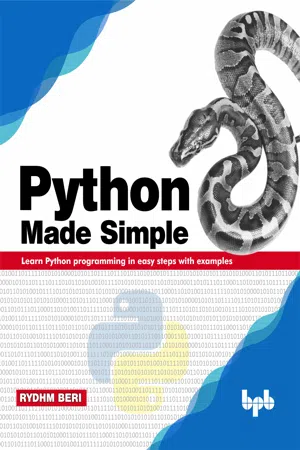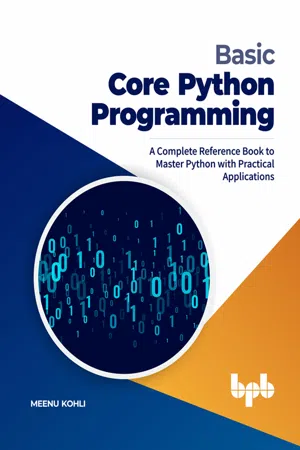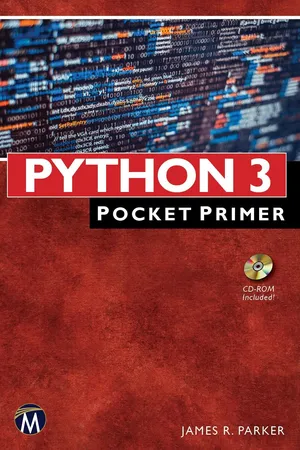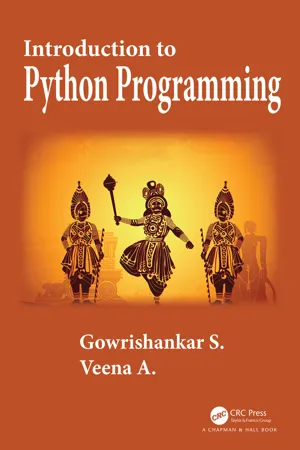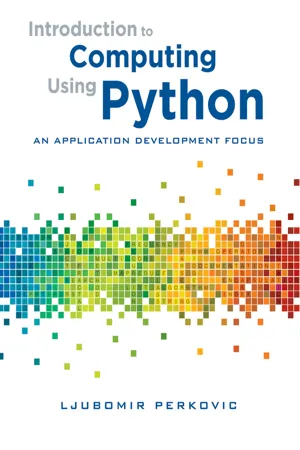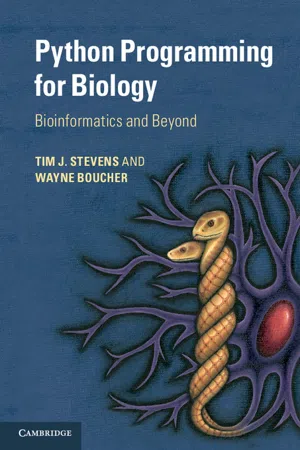Computer Science
Strings in Python
In Python, strings are sequences of characters enclosed in single, double, or triple quotes. They can be manipulated using various built-in string methods and operators. Strings are immutable, meaning they cannot be changed after they are created, and they are widely used for representing text data in Python programs.
Written by Perlego with AI-assistance
Related key terms
1 of 5
9 Key excerpts on "Strings in Python"
- eBook - ePub
Python Made Simple
Learn Python programming in easy steps with examples
- Rydhm Beri(Author)
- 2019(Publication Date)
- BPB Publications(Publisher)
HAPTER 9String Processing
Introduction
A sequence allows you to store multiple elements in an organized and efficient manner. In Python, strings, lists, tuples, and dictionaries are very important sequence data types. In this chapter, we will discuss the string sequence in detail and the possible operations that can be performed on the strings. We will focus on the processing of the strings and formats of the strings to use them in a useful and efficient manner. We will also describe the different methods used to process the strings.Structure
- Introduction to strings
- Creating a string
- Accessing a string
- Methods of a string
- Formatting strings
- Conclusion
- Questions
Objectives
- Understanding the purpose and use of Strings in Python
- Understanding the meaning and syntax to use Strings in Python
- Knowing the different ways to create and access the string
- Understanding the different methods associated with the list
- Understanding how strings can be formatted using parameters
Introduction to strings
Strings are a group of characters. In Python programming, a string is a sequence of characters called items or elements. A string is a linear data structure, which means that elements are stored in a linear order one after the other. A string data type cannot be modified according to the requirement, as it is an immutable data type. This means we cannot make updations in the already existing string object. If we want to update the existing string, we need to create a new string object. Python strings are similar to that of strings in other programming languages.In Python, a string is used to handle large amount of character data, without the need to declare many individual variables or array of characters. The characters of the string are stored in the contiguous memory locations, that is, one after other. A Python string object can have any number of characters. In Python, characters and strings are handled in the same manner. Some of the strings are names, address, father’s name, mother’s name, etc. Every string in Python is stored in the contiguous memory location. - eBook - ePub
Basic Core Python Programming
A Complete Reference Book to Master Python with Practical Applications (English Edition)
- Meenu Kohli(Author)
- 2021(Publication Date)
- BPB Publications(Publisher)
There is no special class for a single character in Python. A character can be considered as a string of text having a length of 1 . String characters can be easily created using single (‘…’) or double (“…”) quotes. It does not make a difference whether you use single quotes or double quotes to create a string variable but it is always better to maintain consistency in your code. Use one type of quotes in your script as a standard.>>>str1 = 'Hello World!!' >>> str2 = "Hello World!!" >>> str1 == str2 TrueA string can be displayed using the in-built print() function.>>>print(str1) Hello World!! >>> print(str2) Hello World!! >>>You may recall that in Chapter 2: Python Basics you learnt about multiline commenting using triple quotes. That is also a form of strings. Strings in triple quotes ('''….''') are also used to create docstrings. The docstrings are the documentation for functions or classes. You can also use triple quotes to create a multiline string variable .Note: As per PEP8, it is advisable to use # instead of triple quotes for comments. >>>a_string =(''' Happy Birthday Dear Friend !!! ''') >>> print(a_string) Happy Birthday Dear Friend !!!Note: UNICODE characters are 137,439 in number to be very precise and there are only 128 ASCII characters. The first 128 characters of UNICODE are the same as ASCII.4.2 Escape characters
Characters such as alphabets, numbers, or special characters can be printed easily. However, whitespaces such as line feed, tab, and so on cannot be displayed like other characters. In order to embed these characters, we have used execution characters. These characters start with a backslash character (\) followed by a character. Some of the important escape sequences in Python are as follows: - eBook - PDF
- Cay S. Horstmann, Rance D. Necaise(Authors)
- 2020(Publication Date)
- Wiley(Publisher)
2.4 Strings Many programs process text, not numbers. Text consists of characters: letters, numbers, punc- tuation, spaces, and so on. A string is a sequence of characters. For example, the string "Hello" is a sequence of five characters. 2.4.1 The String Type You have already seen strings in print statements such as print("Hello") © essxboy/iStockphoto. Strings are sequences of characters. 42 Chapter 2 Programming with Numbers and Strings A string can be stored in a variable greeting = "Hello" and later accessed when needed just as numerical values can be: print(greeting) A string literal denotes a particular string (such as "Hello"), just as a number literal (such as 2) denotes a particular number. In Python, string literals are specified by enclosing a sequence of characters within a matching pair of either single or double quotes. print("This is a string.", 'So is this.') By allowing both types of delimiters, Python makes it easy to include an apostrophe or quotation mark within a string. message = 'He said "Hello"' In this book, we use double quotation marks around strings because this is a common convention in many other programming languages. However, the interactive Python interpreter always displays strings with single quotation marks. The number of characters in a string is called the length of the string. For example, the length of "Harry" is 5. You can compute the length of a string using Python’s len function: length = len("World!") # length is 6 A string of length 0 is called the empty string. It contains no characters and is written as "" or ''. 2.4.2 Concatenation and Repetition Given two strings, such as "Harry" and "Morgan", you can concatenate them to one long string. The result consists of all characters in the first string, followed by all characters in the second string. In Python, you use the + operator to concatenate two strings. - No longer available |Learn more
Python 3
Pocket Primer
- James R. Parker(Author)
- 2017(Publication Date)
- Mercury Learning and Information(Publisher)
C H A P T E R SEQUENCES: STRINGS, TUPLES, AND LISTS 3 I t was mentioned in Chapter 2 that for loops in Python are different from those found in many other languages in that they use a tuple to define the values that will be assigned to the control variable. Tuples are useful in many situations, and are only one example of a wider range of data types that includes strings, tuples, and lists as objects that consist of multiple parts. They are called sequence types. An integer or a float is a single number, whereas a sequence type consists of a collection of items, each of which is a number or a character. Each member of a sequence is given a number based on its position: the first element in the sequence is given 0, the second is 1, and so on. This is a fundamental data structure in Python and has influenced the syntax of the language. Strings A string is a sequence of characters. The word sequence implies that the order of the characters within the string matters, and that is certainly true. Strings most often represent the way that communication between a computer and a human takes place. The order of the characters within a word matters a great deal to a human because some sequences are words and others are not. The string “last” is a word, but “astl” is not. Also, the strings “salt” and “slat” are words and use exactly the same characters as “last” but in a different order. Because order matters, the representation of a string on a computer will impose an order on the characters within, and so there will be a first character, a second, and so on, and it should be possible to access each 36 • PYTHON 3 POCKET PRIMER character individually. A string will also have a length, which is the number of characters within it. A computer language will provide specific things that can be done to something that is a string: these are called operations, and a type is defined at least partly by what operations can be done to something of that type. - No longer available |Learn more
Python 3
Pocket Primer
- James R. Parker(Author)
- 2017(Publication Date)
- Mercury Learning and Information(Publisher)
CHAPTER 3SEQUENCES : STRINGS , TUPLES , AND LISTSI t was mentioned in Chapter 2 that for loops in Python are different from those found in many other languages in that they use a tuple to define the values that will be assigned to the control variable. Tuples are useful in many situations, and are only one example of a wider range of data types that includes strings, tuples, and lists as objects that consist of multiple parts. They are called sequence types. An integer or a float is a single number, whereas a sequence type consists of a collection of items, each of which is a number or a character. Each member of a sequence is given a number based on its position: the first element in the sequence is given 0, the second is 1, and so on. This is a fundamental data structure in Python and has influenced the syntax of the language.StringsA string is a sequence of characters. The word sequence implies that the order of the characters within the string matters, and that is certainly true. Strings most often represent the way that communication between a computer and a human takes place. The order of the characters within a word matters a great deal to a human because some sequences are words and others are not. The string “last” is a word, but “astl” is not. Also, the strings “salt” and “slat” are words and use exactly the same characters as “last” but in a different order.Because order matters, the representation of a string on a computer will impose an order on the characters within, and so there will be a first character, a second, and so on, and it should be possible to access each character individually. A string will also have a length - eBook - ePub
- Gowrishankar S, Veena A(Authors)
- 2018(Publication Date)
- Chapman and Hall/CRC(Publisher)
5 StringsAIM Use indexing and built-in string methods to manipulate and process the string values. LEARNING OUTCOMES At the end of the chapter, you are expected to • Access individual characters in a string and apply basic string operations. • Search and retrieve a substring from a string. • Use string methods to manipulate strings.String usage abounds in just about all types of applications. A string consists of a sequence of characters, which includes letters, numbers, punctuation marks and spaces. To represent strings, you can use a single quote, double quotes or triple quotes.5.1 Creating and Storing Strings Strings are another basic data type available in Python. They consist of one or more characters surrounded by matching quotation marks. For example, 1. >>> single_quote = 'This is a single message' 2. >>> double_quote = "Hey it is my book" 3. >>> single_char_string = "A" 4. >>> empty_string = "" 5. >>> empty_string = '' 6. >>> single_within_double_quote = "Opportunities don't happen. You create them." 7. >>> double_within_single_quote = "Why did she call the man 'smart'?" 8. >>> same_quotes = 'I\'ve an idea' 9. >>> triple_quote_string = '''This … is … triple … quote''' 10. >>> triple_quote_string 'This\nis\ntriple\nquote' 11. >>> type(single_quote) <class 'str'>Strings are surrounded by either single ➀ or double quotation marks ➁. To store a string inside a variable, you just need to assign a string to a variable. In the above code, all the variables on the left side of the assignment operator are string variables. A single character is also treated as string ➂. A string does not need to have any characters in it. Both ''➃ and "" ➄ are valid strings, called empty strings. A string enclosed in double quotation marks can contain single quotation marks ➅. Likewise, a string enclosed in single quotation marks can contain double quotation marks ➆. So basically, if one type of quotation mark surrounds the string, you have to use the other type within it. If you want to include the same quotation marks within a string as you have used to enclose the string, then you need to preface the inner quote with a backslash ➇. If you have a string spanning multiple lines, then it can be included within triple quotes ➈. All white spaces and newlines used inside the triple quotes are literally reflected in the string ⑩. You can find the type of a variable by passing it as an argument to type() function. Python strings are of str - eBook - PDF
Introduction to Computing Using Python
An Application Development Focus
- Ljubomir Perkovic(Author)
- 2012(Publication Date)
- Wiley(Publisher)
The Python string type, denoted str, is used to represent and manipulate text data or, in other words, a sequence of characters, including blanks, punctuation, and various symbols. A string value is represented as a sequence of characters that is enclosed within quotes: >>> 'Hello, World!' 'Hello, World!' >>> s = 'hello' >>> s 'hello' The first expression, 'Hello, world!', is an expression that contains just one string value and it evaluates to itself, just as expression 3 evaluates to 3. The statement s = 'hello' assigns string value 'hello' to variable s. Note that s evaluates to its string value when used in an expression. String Operators Python provides operators to process text (i.e., string values). Like numbers, strings can be compared using comparison operators: ==, !=, < , >, and so on. Operator ==, for example, returns True if the strings on either side of the operator have the same value: >>> s == 'hello' True >>> t = 'world' >>> s != t True >>> s == t False 24 Chapter 2 Python Data Types While == and != test whether two strings are equal or not, the comparison operators < and > compare strings using the dictionary order: >>> s < t True >>> s > t False (For now, we appeal to intuition when referring to dictionary order; we define it precisely in Section 6.3.) The + operator, when applied to two strings, evaluates to a new string that is the con- catenation (i.e., the joining) of the two strings: >>> s + t 'helloworld' >>> s + ' ' + t 'hello world' In the second example, the names s and t are evaluated to the string values 'hello' and 'world', respectively, which are then concatenated with the single blank space string ' '. If we can add two strings, can we, perhaps, multiply them? >>> 'hello ' * 'world' Traceback (most recent call last): File "", line 1, in 'hello ' * 'world' TypeError: cannot multiply sequence by non-int of type 'str' Well . - eBook - PDF
Python Programming for Biology
Bioinformatics and Beyond
- Tim J. Stevens, Wayne Boucher(Authors)
- 2015(Publication Date)
- Cambridge University Press(Publisher)
For example, you could have: x = x + 1 which increases the value of x by 1. Python allows a shorthand notation for this kind of statement: x += 1 Also, it allows similar notation for the other arithmetic operations, for example: x *= y assigns x to be the product of x and y, or in other words x is redefined by being multiplied by y . String manipulation Text items in Python are called strings, referring to the fact that they are strings of characters. String functionality is an important part of the Python toolbox. For example, a file on disk (covered in Chapter 6) is read as a string or a list of strings; a file can be viewed as a collection of characters. Here, even if part of the loaded file represents a number, it is initially represented as a string of characters, not a proper Python numeric object. In Python, strings are not modifiable. This might seem like a limitation, but in fact it rarely is because it is easy enough to create a new, modified string from an existing string. And since strings are not modifiable it means that they can be placed in sets and used as keys in dictionaries, both of which are exceedingly useful. In this section we will illustrate some basic manipulations on strings using the following example string: text = 'hello world' # same as double quoted "hello world" In some ways a string can be thought of as a list of characters, although in Python a list of characters would be a different entity (see below for a discussion of lists). Note that when we refer to something in a string as being a character, we don’t just mean the regular symbols for letters, numbers and punctuation; we also include spaces and formatting codes (tab stop, new line etc.). You can access the character at a specific position, or index, using square brackets: text[1] # 'e' text[5] # ' ' – a space Note that the index for accessing the characters of a string starts counting from 0, not 1. Thus the first character of a string is index number 0. - eBook - PDF
Fundamentals of Python
First Programs
- Kenneth Lambert(Author)
- 2018(Publication Date)
- Cengage Learning EMEA(Publisher)
In this section, we examine the internal structure of a string more closely, and you will learn how to extract portions of a string called substrings . The Structure of Strings Unlike an integer, which cannot be decomposed into more primitive parts, a string is a data structure . A data structure is a compound unit that consists of several other pieces of data. A string is a sequence of zero or more characters. Recall that you can mention a Python string using either single quote marks or double quote marks. Here are some examples: >>> Hi there! 'Hi there!' >>> '' >>> 'R' 'R' Note that the shell prints a string using single quotes, even when you enter it using double quotes. In this book, we use single quotes with single-character strings and double quotes with the empty string or with multi-character strings. When working with strings, the programmer sometimes must be aware of a string’s length and the positions of the individual characters within the string. A string’s length is the num-ber of characters it contains. Python’s len function returns this value when it is passed a string, as shown in the following session: >>> len ( Hi there! ) 9 >>> len ( ) 0 The positions of a string’s characters are numbered from 0, on the left, to the length of the string minus 1, on the right. Figure 4-1 illustrates the sequence of characters and their posi-tions in the string Hi there! . Note that the ninth and last character, '!' , is at position 8. Figure 4-1 Characters and their positions in a string H r e h t i e 0 6 5 4 3 2 1 7 ! 8 Copyright 2019 Cengage Learning. All Rights Reserved. May not be copied, scanned, or duplicated, in whole or in part. Due to electronic rights, some third party content may be suppressed from the eBook and/or eChapter(s). Editorial review has deemed that any suppressed content does not materially affect the overall learning experience.
Index pages curate the most relevant extracts from our library of academic textbooks. They’ve been created using an in-house natural language model (NLM), each adding context and meaning to key research topics.
